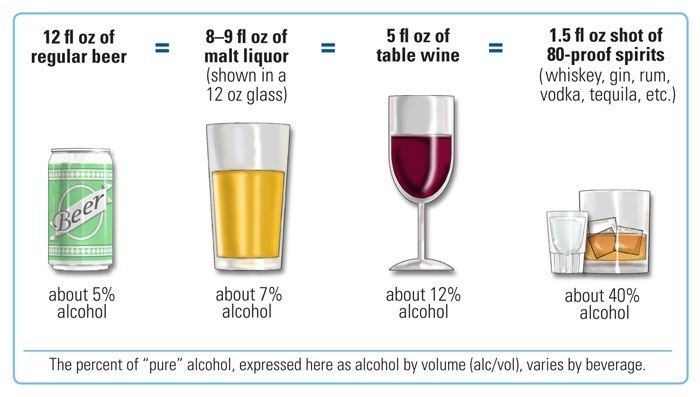 | ||
A standard drink is a measure of alcohol consumption representing a hypothetical beverage which contains a fixed amount of pure alcohol. A standard drink varies in volume depending on the alcohol concentration of the beverage (for example, a standard drink of spirits takes up much less space than a standard drink of beer), but it always contains the same amount of alcohol and therefore produces the same amount of drunkenness.
Contents
- Definitions in various countries
- Calculation of pure alcohol mass in a serving
- Time to metabolise
- References
For example, in the United States, a standard drink contains about 14 grams of alcohol. This roughly corresponds to a 12-US-fluid-ounce (350 ml) glass of beer, a 5-US-fluid-ounce (150 ml) glass of 12% wine (no longer the norm, however), or a 1.5-US-fluid-ounce (44 ml) glass of a spirit.
Different countries define standard drinks differently. For example, in Australia, a standard drink contains 10 grams of alcohol, but in Japan, it contains nearly 20 grams. In addition, a standard drink is often different from normal serving size in the country in which it is served.
Labeling is usually required to give an indication of alcoholic content of a serving. Australia requires that "the label on a package of an alcoholic beverage must include a statement of the number of standard drinks in the package".
The term "standard drink" was used in the United Kingdom in the first guidelines (1984) that published "safe limits" for drinking, but this was replaced by reference to "alcohol units" in the 1987 guidelines and that term has been used in all subsequent UK guidance. A unit of alcohol is defined as 10 millilitres (8 grams) of pure alcohol. This definition is independent of the strength (% ABV) and amount (volume) of any individual alcoholic beverage. The number of units of alcohol in a bottle or can (and, optionally, the number of units in a typical serving) are indicated on the drink container. Typical servings deliver 1–3 units of alcohol.
Definitions in various countries
The amount of alcohol is stated in the table in both grams and millilitres. The number of standard drinks contained in 500ml of beer of 5% ABV (a typical large drink of beer) is stated for comparison.
Calculation of pure alcohol mass in a serving
Pure alcohol mass in a serving can be calculated if concentration, density and volume are known.
For example, 0.35 litre glass of beer with ABV of 5.5% has 15.2 grams of pure alcohol. Pure alcohol has density of 789.24 g/l (at 20 °C).
When drink size is in fluid ounces (which differ between the UK and the US), the following conversions can be used:
One should bear in mind that a pint in the UK is 20 UK fluid ounces, whereas a pint in the US is only 16 US fluid ounces.
Time to metabolise
On average, it takes about one hour for the body to metabolise (break down) one standard drink as defined by U.S. guidelines (i.e. 12 ounces of 5% beer, 5 ounces of 12% wine, or 1.5 ounces of 40% liquor). However, this can vary with body weight, sex, age, personal metabolic rate, recent food intake, the type and strength of the alcohol, and medications taken. Alcohol may be metabolised more slowly if liver function is impaired.
